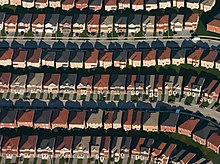Division of land

A property division (or parceling ) is in property law the division of an existing property into two or more legally independent properties.
General
A plot of land registered in the land register does not always have to be kept in the registered size, but can change its plot area . The original area can either increase or decrease. However, this must be done in the land register, which is only possible if legal provisions provide for it. The division of land is not expressly regulated in the BGB . In contrast to the property association ( Section 890 (1) BGB) and the attribution (Section 890 (2) BGB), other provisions must be used analogously.
Legal issues
The division of land is anchored in building law in Section 19 of the Building Code (BauGB). According to this, the division of a property is the declaration of the property owner given to the land registry or otherwise made recognizable that a portion of the property is to be written off in the land registry and registered as an independent property or as a property together with other properties or parts of other properties. The division of one property into (at least) two pieces of land is done by depreciation in accordance with Section 2 (3) GBO , according to which part of a piece of property may only be written off if it is recorded in the official register under a special number. The real division of a built-up plot of land is only permissible if this does not create any conditions that violate building or planning regulations. For example, the requirements set out in the relevant state building regulations for clearance areas , fire protection , development and access for the fire brigade must be observed.
The declaration of the owner has to be made by notarial certification according to § 29 GBO .
Legal consequences
The land registry makes the entry on the basis of the certified declaration by deleting the property areas to be divided from the inventory of the land register and transferring them to a new land register. The original property rights continue to the newly created properties, property liens remain in place in accordance with Section 1132 BGB. In the case of easements , if the ruling property is divided, the easement continues to exist for the newly formed parts ( § 1025 BGB), this also applies to real burdens ( § 1109 BGB).
Due to certain legal consequences resulting therefrom (. Eg land transfer , real estate tax , ownership ), the pitch is a change in the detection or continuation-proof document, also which is property - or real estate register to track.
execution
In Germany, the surveying and cadastral administration as well as publicly appointed surveying engineers are authorized to carry out divisions . If new parcels have been created , this leads to an extract from the proof of change for those involved , which also forms the basis for entry in the inventory of the land register. An exception is the state of Bavaria, in which only the surveying and cadastral administration is allowed to carry out divisions. In Austria civil engineers in the field of surveying and civil servants in the surveying administration are responsible.
The most common case of property division is the division of a property into co-ownership shares within the framework of apartment ownership by means of a declaration of division , whereby, according to Section 8 (1) WEG, with each share the individual property in a specific apartment or in specific rooms not used for residential purposes ( partial ownership ) in one the building constructed or to be constructed is connected to the property. In legal terms , it is a real property division, but it is actually an ideal one because no new properties are created.
In a redevelopment area , in accordance with Section 144 (2) No. 5 BauGB, the division of land requires the approval of the municipality.
Individual evidence
- ↑ BayObLG , decision of July 12, 1972, Az .: 2 Z 14/72
- ↑ Johannes Handschumacher, Real Estate Law praxisnah , 2014, p. 20
- ↑ Hessian administration for soil management and geographic information, division (decomposition) measurement